|
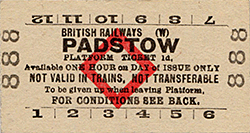 |
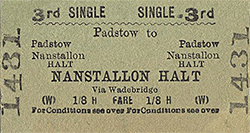 |
 |
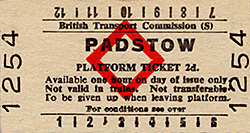 |
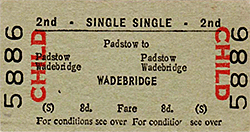 |
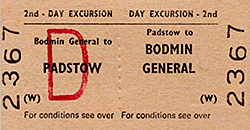 |
old45.jpg)
Some investigation has enabled this idyllic scene to be identified. The train has just crossed Little Petherick Creek bridge and is approaching what is today Dennis Cove Campsite. It is the same location as the photograph above showing a Beattie well tank but looking in the opposite direction. Dennis Hill is to the right but the tall object in the right background is a telegraph pole, not the obelisk on the hilltop. The train will shortly arrive at Padstow and the locomotive, in Southern Railway livery, is Drummond T9 No.709. Dating from the year that the Padstow line opened, she went on the become BR No.30709 and survived until July 1961. The headcode tells us that the train has come from the Halwill direction. Only the first vehicle of the train can be seen but at the wrong angle for a positive identification. All that can be discerned is that it is a passenger brake, perhaps a brake third or lavatory brake third.
Photo from Malcolm McCarthy collection
Photo from Malcolm McCarthy collection
old50.jpg)
No train is visible in this believed 1930s view of Little Petherick Creek bridge so the cloud of steam is concluded as being from a light locomotive which, the waft of the steam suggests, is heading towards Padstow. The locomotive may have been heading for Padstow to take up service on a passenger or goods working or it could have been from a termination at Wadebridge and is running to Padstow for turning, there being no provision for such at Wadebridge. A 'light' locomotive is one running on its own without any form of train and such movements are commonly referred to as 'light engine movements' historically and as 'light locomotive' in modern parlance. Where a train, as opposed to a locomotive, including multiple unit stock, undertakes the same movement it is referred to simply as 'empty coaching stock'. 'Light' in this context is not confined to railways, being also used by some bus companies and especially those which were once partly owned or in some way controlled by railway companies. The topography of the Cornish coast is evident in this view, with the bridge approached from the Wadebridge direction on an embankment with the line then plunging into a cutting on the Padstow side. Note that the signal, right, is showing either caution or danger. It is thought to have been a Distant and although it can be seen in a number of photographs none are clear enough to permit conclusive identification. There was another signal on the opposite side on the bridge, this one possibly Padstow Outer Home. Signalling diagrams from Padstow have survived but of those which have been seen
, none are very legible.
, none are very legible.
Photo
from Malcolm McCarthy collection
old60.jpg)
Padstow station sometime in Southern Railway days with one of the 0298 class Beattie well tanks waiting with a train for Wadebridge and Bodmin. 'Well Tank' refers to locomotives which had a water tank mounted underneath the footplate. The motley collection of vehicles forming the train includes a cattle wagon. Identity of the locomotive has proved difficult, albeit made easier by the fact that only three of the class remained by Southern days. It appears to be No.3329, which had been renumbered from 0329 in September 1935. Later becoming BR No.30586, it was unfortunately the only one of the three survivors not to enter preservation.
Photo from Malcolm McCarthy collection
Photo from Malcolm McCarthy collection
old64.jpg)
Sometime in the 1930s, 0298 class Beattie well tank No.3329 shunts the sidings beneath the loading gauge in front of the goods shed on the western side of Padstow station site. The story of the three Beatties which survived into the twentieth century and, in the case of two, beyond, has been told with other images so needs no repetition here. This three-quarter view does, however, show well the short 2-4-0 wheelbase of these locomotives which was responsible for their survival to work the
Wenford Bridge branch.
Photo from Malcolm McCarthy collection
old66.jpg)
old68.jpg)
Wenford Bridge branch.
Photo from Malcolm McCarthy collection
old66.jpg)
Referring to two other images, one showing No.3329 shunting a 6-wheel van and No.1842 arriving at Padstow with a 2-car train plus two vans, this was the scene a short while later. No.3329 is still busy shunting while N class No.1842 has been released from its train and is reversing out of the station. She will continue to the points seen in the distance and then draw forward to the turntable and servicing facilities. At extreme left the edge of the turntable pit can just be seen and beyond that what appears to be a pile of ash from locomotive fireboxes. Larger locomotives seen at Padstow were generally based at Exmouth Junction while the Beatties, the 0298 class, were shedded at Wadebridge which was a sub-shed of Exmouth Junction. At nationalisation Exmouth Junction shed became 72A while Wadebridge became 72F.
Photo from Malcolm McCarthy collection
Photo from Malcolm McCarthy collection
old68.jpg)
Duty 604 and Beattie No.3329 again in Southern Railway days. The short train at the platform still had its tail lamp in situ on the end facing the camera so the suggestion is that No.3329 had recently arrived with this train and is either running round or possibly proceeding for servicing, having created a cloud of steam that all but blots out the Metropole Hotel in the background. Of note is that by this time the signal had received an upper quadrant arm, replacing the previous wooden lower quadrant arm. The brake/luggage van at far left is something of a mystery. Although on wheels, it has lost its lookout duckets and appears to be grounded and possibly in use as some sort of shed.
Photo
from Malcolm McCarthy collection
old69.jpg)
Beattie well tank No.3329 is seen here arriving at Padstow with possibly the same train as seen in another image showing the locomotive running round. The date is unknown but will be after September 1935 when No.3329 was renumbered from 0329. The landmark Metropole Hotel, which dated from 1904 and is still in business at the time of writing, can be seen in the background.
Photo
from Malcolm McCarthy collection
old70.jpg)
Maunsell N class 2-6-0 No.812 arrives at Padstow with one of the ex-LSWR 2-car sets. Just below the cantrail of the first carriage the car number can just been seen and, midway, the Southern Railway name. The photograph will date from early Southern Railway years as No.812, new to the SE&CR in 1920 and painted in that company's dreadful grey livery of the time, was soon renumbered A812 following takeover by the Southern. It is said that the 'A' prefix denoted that locomotives so numbered were the responsibility of Ashford Works when due for overhaul; in the event, sometime after 1928 she became No.1812 and in 1949 BR No.31812. She survived until July 1964 when she was withdrawn from Exmouth Junction shed. The origin of the odd 'Mongoliper' nickname given to the N class is something of a mystery. Perhaps it derived from 'Mogul' the name given to the 2-6-0 wheel arrangement but one suspects the origin might be something which today may not be considered 'politically correct'.
old71.jpg)
old80.jpg)
Photo
from Malcolm McCarthy collection
old71.jpg)
No. 1842 is seen on the turntable at Padstow. In the right foreground we have a good view of one of the ground shunt signals of the style peculiar to the Southern Railway. This would suggest that the photograph was taken a few years into the Southern's reign and perhaps after 1928, in which case the locomotive would be No.1842. This particular locomotive was one of the so-called 'Woolworths' constructed from kits of parts supplied by Woolwich Arsenal and with a boiler supplied by North British. It is worth mentioning that unlike the diesel locomotives built by North British, their steam locomotives and components for them were of excellent quality and once supplied to railways across the world. In the left background, one of the Beattie well tanks is departing the station past Padstow's delightful signal box and recently installed upper quadrant signal. In the absolute left background the Metropole Hotel stands sentinel over the scene while, left of centre, the fish shed is seen. In front of the fish shed and to the left of the locomotive tender a couple of grounded carriage bodies are seen.
Photo
from Malcolm McCarthy collection
old80.jpg)
A closer view of Maunsell N class 2-6-0 No.1842 on the turntable at Padstow sometime after 1928. In this view, she has just driven onto the turntable and is awaiting turning, this view looking eastwards towards the River Camel. It will be noticed that the locomotive only just fits on the turntable. The N class was 57ft 10in long over buffers and the overhang outside the turntable is obvious. This will be the 50ft turntable, replaced in 1947 by a 65ft example presumably to suit the Bulleid Pacifics with their length of a little over 67ft. The plates either side of the locomotive's smokebox are smoke deflectors. The purpose of these was to create an upwards airflow, when the locomotive was in motion, to deflect exhaust clear of the cab. Smoke deflectors came in various shapes and were mounted in varying positions. Found necessary on only certain classes, in Britain they were normally fitted only
to tender locomotives.
to tender locomotives.
Photo
from Malcolm McCarthy collection
old85.jpg)
The Adams O2 class 0-4-4Ts are described with another image elsewhere so need no repetition here. This is No.182 at Padstow on an unknown date. This locomotive was from the initial batch of ten built 1889/90 at Nine Elms, the order number for which gave rise to the designation of the entire class. As with certain other classes, the O2s retained their LSWR numbers right through to nationalisation with No.182 becoming British Railways No.30182 with the exception of being numbered E182 for a time. The 'E' signified Eastleigh, which was responsible for overhaul. No.30182 was withdrawn in 1960 from Exmouth Junction where she had been since 1958 having been reallocated there from Yeovil. The above view is difficult to date with any accuracy, not least because the locomotive is in filthy condition and her livery thus impossible to determine. The train comprises an ex-LSWR 2-car set constructed circa 1910 with a third vehicle which appears to be a Maunsell steel panelled carriage.
Photo from John Mann collection
old79.jpg)
Photo from John Mann collection
old79.jpg)
No names of these three staff members at Padstow are known and their grades are also uncertain. The only definite observation is that none is the stationmaster as both LSWR and SR stationmasters' caps were quite distinctive. The date is also unrecorded, but on the right at the fish shed is a Southern Railway 'Van B' known alternatively as 'Bogie B'. We are therefore looking back in time into Southern Railway days or perhaps very early BR days.
Photo from Malcolm McCarthy collection
Photo from Malcolm McCarthy collection
Click here for Padstow Gallery 6:
Early BR - September 1959

|
| Last updated: Wednesday, 07-Mar-2018 14:50:27 CET | © 1998-2016 Disused Stations |

 Home Page
Home Page